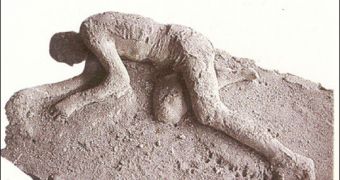A team of Italian volcanologists from the University of Naples Federico II, comprised of Claudio Scarpati, Giuseppe Luongo and Annamaria Perrotta, have managed to use the latest techniques in order to render a pretty accurate image of the final hours in the life of a Pompeii-based house during the eruption of mount Vesuvius in 79 AD. The study was focused on the ongoing events in the house of Iulius Polybius, located on the main Pompeian street, named Via dell'Abbondanza. "This house has yielded rich and diverse archaeological findings. Moreover, it features the most complete stratified sections of Pompeii's volcanic deposit," explained Scarpati to Discovery on the house's importance.
On August 24th 79 AD, when the eruption began, "Polybius' house was inhabited by 12 people, including a young woman in advanced pregnancy. They decided to remain in the house, most likely because it was safer for the pregnant woman. Given the circumstances, it was the right strategy," shared Scarpati. Subsequent research showed that it was most likely a family of two parents and their six children, a visiting cousin and his young wife, pregnant in the last month, as well as a pair of slaves.
A massive (15 km or 9 mile tall) conical column of smoke rose from the volcanic crater, spewing large amounts of pumice stone towards the city and its surroundings. Recent studies indicated that this preliminary event was actually responsible for about 38% of the deaths of the Pompeians. In six hours, the roof and frontal side of Polybius' house had collapsed, and the family retired in the back rooms, whose steeper roof prevented pumice from accumulating. By next morning, 3 meters (10 feet) of pumice covered the city.
Then, the eruption's first stage ended and the pyroclastic currents (rapid and up to 700 Celsius / 1300 Fahrenheit hot rock and gas flows) took in. "The first pyroclastic currents arrived from the north and overtopped the rear part of the house. The currents moved into the garden and advanced toward the front of the house. No escape was possible for the people there. The ash reached every corner in the house and suffocated its inhabitants," concluded Scarpati.
"The position of some skeletons on the volcanic deposit indicates that some individuals were lying on beds at the moment of death," he added. Polybius' family had accepted their fate, unlike others who tried to run from the city. "It was impossible to survive that eruption. Even though we calculated that 75 to 92 percent of the residents escaped the town at the first signs of the crisis, it is not possible to know how successful those fugitives were. Hundreds of victims were recovered from the relatively small excavations outside the city walls," pointed the scientist.

 14 DAY TRIAL //
14 DAY TRIAL //